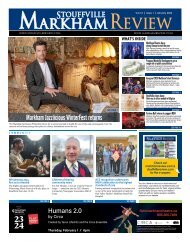Stouffville Review, December 2022
You also want an ePaper? Increase the reach of your titles
YUMPU automatically turns print PDFs into web optimized ePapers that Google loves.
4 STOUFFVILLE REVIEW COMMUNITY<br />
DECEMBER <strong>2022</strong><br />
Many human trafficking victims are as young as 13<br />
STOUFFVILLEREVIEW.COM<br />
BY JENNIFER MCLAUGHLIN<br />
Local Journalism Initiative Reporter<br />
Human trafficking for sexual exploitation<br />
is one of the most rapidly growing and<br />
lucrative crimes worldwide, and it’s happening<br />
right here in York Region.<br />
The impact on victims, survivors, families,<br />
and communities is devastating.<br />
The Anti-Human Trafficking York<br />
Region Conference <strong>2022</strong> was recently<br />
presented virtually over four sessions. Signs<br />
and risk factors of human trafficking, community<br />
support for victims and survivors,<br />
and legislation to combat it were among the<br />
topics discussed.<br />
Human trafficking involves recruiting,<br />
transporting, transferring, receiving, holding,<br />
concealing, harbouring, or exercising<br />
control, direction, or influence over a<br />
person for exploitation.<br />
The conference focused on human trafficking<br />
involving sexual exploitation, given<br />
its prevalence in York Region. Jasmine<br />
De Fina, a human trafficking specialist<br />
for Victim Services of York Region and<br />
executive director of SafeHope, Canada’s<br />
only long-term comprehensive program for<br />
survivors of human trafficking, spoke on the<br />
conference’s opening night.<br />
She explained that a widespread<br />
misconception about human trafficking is<br />
that the victim is aware of the situation in<br />
which they’re getting involved. The victim<br />
is led to believe that they have a choice, but<br />
through threat, force, coercion, manipulation,<br />
fraud, or abuse of power, the trafficker<br />
gets the victim to do something they don’t<br />
want to do.<br />
A trafficker may meet the fundamental<br />
needs of the victim by providing food,<br />
drugs, or alcohol. Sometimes, the victim<br />
will receive lavish gifts. A dependency on<br />
the trafficker grows.<br />
She explained that the cycle of human<br />
trafficking for the purpose of sexual exploitation<br />
is very similar to domestic violence<br />
in terms of the methods of control, often<br />
starting in a “honeymoon phase.” Initially,<br />
the trafficker is highly attentive and loving<br />
but eventually starts to pull back and seems<br />
angry. The victim is desperate to feel love<br />
and will do anything to get it back.<br />
In Canada, the majority of victims<br />
are women and girls. The average age of a<br />
young trafficking victim is 13.<br />
There are a variety of insecurities that<br />
can make an individual vulnerable to the<br />
dangers of trafficking. Low self-esteem,<br />
drug dependency, and abandonment are<br />
just a few.<br />
Bonnie Harkness, chief operating<br />
officer of 360°kids, spoke to conference<br />
participants about the connection between<br />
homelessness and human trafficking. She<br />
explained that some kids become homeless<br />
because of human trafficking, and some<br />
become victims of human trafficking because<br />
they are homeless. These individuals<br />
rely on “survivor sex” through trafficking<br />
to fulfil basic needs like food and shelter.<br />
The 360°kids HOPE Program provides<br />
transitional housing and wrap-around<br />
services for female survivors of human<br />
trafficking aged 16-26 in York Region.<br />
She added that given York Region is<br />
considered a relatively affluent area, it’s<br />
not only impoverished youth who become<br />
susceptible to trafficking. Kids from more<br />
wealthy families tend to be less “street<br />
smart” and can be more vulnerable to the<br />
deception that occurs when getting lured<br />
into trafficking.<br />
It’s crucial, said Harkness, to teach<br />
our kids what to look for so they are aware<br />
of the dangers that can occur in various<br />
settings and situations.<br />
Traffickers lure their victims through<br />
dating apps and other online connections,<br />
at schools, through friends or family members,<br />
and at social meeting places such as<br />
shopping malls. Visit victimservices-york.<br />
org and 360kids.ca for information.

















